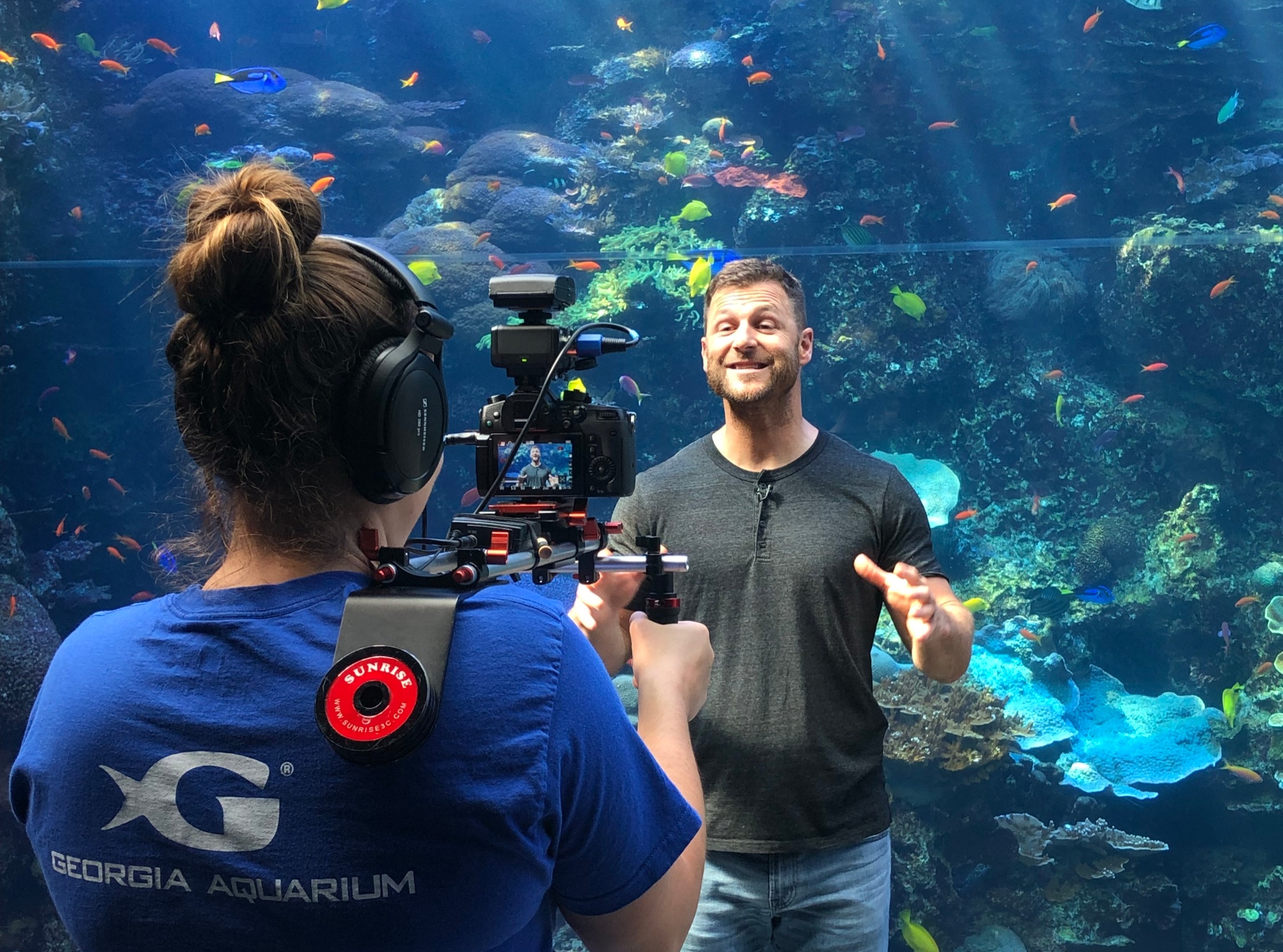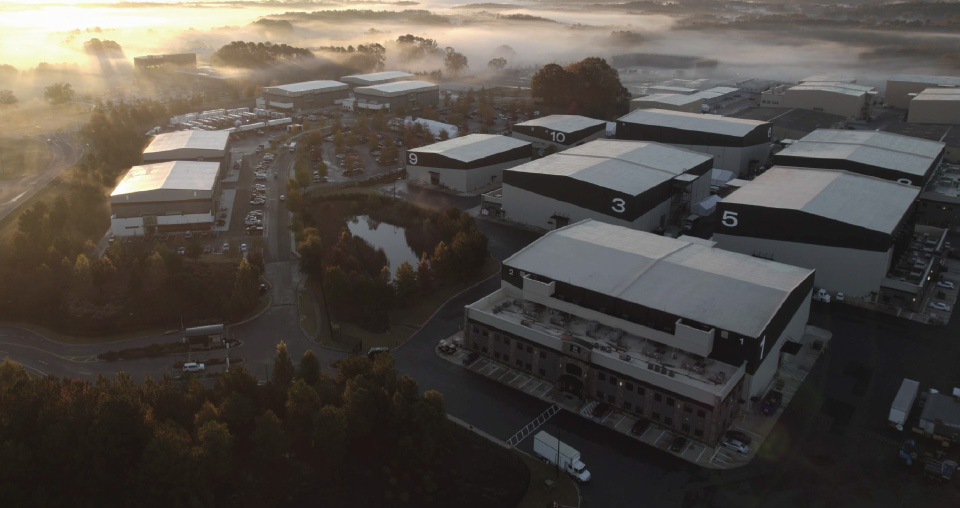Animal Planet Features the Georgia Aquarium for New Docu-series

There’s an energy bubbling above the surface of the water at The Georgia Aquarium. Not something tangible that requires a call to the electrician. The Ocean Voyager exhibit one can see excitement and joy on the faces of every guest as they stand awestruck in front of 6.3 million gallons of water, brimming with thousands of fish, a 400-pound rescued sea turtle named “Tank”, the majestic whale sharks and manta rays. That energy is present even before the doors are open to the public each day. Each aquarium employee knows just how special their workplace is, and the tens of thousands of aquatic animals living within those walls seem to be in on the magic too.
It could be because The Georgia Aquarium is one the of the largest aquariums in the western hemisphere (it was the largest in the world until 2012 when an aquarium in Singapore claimed the title), or maybe it’s the sheer magnitude of the more than 700 aquatic animal species living in 10 million gallons of fresh and salt water which compelled the Animal Planet network to make the Georgia Aquarium the subject of its latest docu-series, The Aquarium. After the wild success of the show, The Zoo, which tells stories from the Bronx Zoo, The Aquarium serves as a successor to that show and is a 10-episode series detailing a day in the life of the animals who call the Georgia Aquarium home, as well as the handlers who care for them. The show premiered on May 19th. Some episodes focus on the interesting stories of specific animals such as Pinkie, an elderly otter with a recurring nose bleed. Others follow the aquarium staff into the wild as they work to release animals they have rehabilitated back into their natural habitats. All ten episodes are a compelling peek into just how complex it is to care for the animals who call the Georgia Aquarium home, as well as the conservation efforts of the aquarium staff as a whole.

It may come as a surprise considering The Aquarium’s flawless fit into Animal Planet’s line-up of shows, but the initial concept for the show came from the Aquarium team itself. It was an organizational goal to be featured in a full-scale docu-series, and they believed strongly that such a show would sustain best as a part of the Animal Planet family. The aquarium staff worked with the team at Left/Right Productions (the production company behind shows such as Ride with Norman Reedus, Small Town Security, Mob Wives, Odd Mom Out, and in this case most importantly, The Zoo) to create a pitch reel to present to the network, and the rest, as they say, is history. The aquarium team’s initial insight also proved to be spot-on, as the partnership between the underwater zoo and the network has been a perfect match.
Although the negotiation period between the two did take a few months, a shared goal made the process easy. That goal? To bring the animals that live at the aquarium closer to people to hopefully inspire them to action. This shared vision made some specific terms of the agreement easy for both sides: The network wanted complete access to the aquarium, its animals, exhibits and staff, and the aquarium wanted to ensure that the real keepers who care for and work with the animal’s day in and day out were the ones shown in the series. These similar goals of authenticity and a desire for an accurate representation of what life for and among the creatures at the aquarium looks like made for a relaxed co-working environment for the aquarium’s staff and the production team. While it was indeed a change of pace initially for keepers and other staff to see camera equipment and filming teams setting up shop in their work environment, soon it became commonplace, and with a lengthy filming timeline of six months, it quickly became the new normal for life at the aquarium.
But Animal Planet’s production team isn’t the first to have seen the value of filming at Atlanta’s beloved aquarium. In fact, the aquarium team receives close to 200 requests each year to film in the space, and just this past March, hired a manager of video content and production specifically to field those requests and coordinate with production teams throughout the filming process.
Marcy Hendryx began working as a contractor for the aquarium in February 2018, but quickly proved the value of her role and was brought on full time. She shares, “All the location fees the aquarium earns during these shoots go right back to our research and conservation efforts, so it is a no-brainer for us to promote the Georgia Aquarium as a filming location.”
But what type of productions take place there? The list is broad and varied. There are request forms on the aquarium’s website specifically for filming, photographer and blogger shoots, and requests that have been approved in just the past few years include everything from commercials for Greyhound and Google Fiber to promotional videos for The Home Depot and Carvel Ice Cream to a contestant intro for the show, The Bachelorette, a TV special for the Red Bull Soapbox Race and the feature films Pitch Perfect 3, Miracles From Heaven and Alvin and The Chipmunks 4: Road Chip. And the requests that don’t get approved? If you can think it up, it has been requested, and no, the aquarium won’t allow high schoolers to come free dive into the tanks for a YouTube video (insert wry smile here).



However, despite a large number of productions that do film at the aquarium, there is a lengthy and detailed process that takes place before any production gets the green light. “Our primary concern is the safety of the animals who live here,” shares Emily Collins, the aquarium’s multimedia communications specialist. It is the staff’s job to make sure that production doesn’t negatively impact any of the creatures or the guests there to see them. Many requests are declined, or at least amended before approval. One such story shared by Collins and Hendryx involved filming an extravagant dance number in the film Pitch Perfect 3. The scene takes place in front of one of the large acrylic viewing windows of one of the tanks, and the original lighting request would have been too invasive for the fish living inside. The aquarium staff not only countered the request by reducing the overall wattage of the lighting considerably, but they also gradually introduced the animals in the habitat to the increased light before actual filming to minimize any effect on them at all.
“We use that opportunity to get what we need,
with the least amount of impact on the animals,”
Typically, underwater filming by outside production teams is not allowed due to the threat it can pose to the animals. The aquarium’s own filming teams regularly step in and capture any underwater footage requests themselves. Collins shares that there are already scheduled dives each day within the aquarium’s programming. That is when she and other videographers go into the tanks to shoot any needed footage, both for the aquarium’s own use and outside projects. “Since the animals are accustomed to those scheduled disruptions in their habitats, we use that opportunity to get what we need, with the least amount of impact on the animals,” she says.
But while the concept of underwater filming seems like it could be fraught with challenges to the layman, the aquarium team makes it appear effortless. Collins is rarely without her trusty Panasonic Lumix GH5, with which she captures both still shots and video. When it’s time to dive, she and the rest of the filming team use Nauticam underwater housing equipment to keep their cameras safe. Water sensors, vacuum seals and buoyancy weights on the housings all work to make their job as easy as possible. While the team’s professionalism means reshoots aren’t often required, they never mind getting back in the tanks.
When speaking with Collins and fellow diver Chris Miller, the assistant manager of the dive emersion program and member of the videography team, their passion for getting in the water is evident. In fact, both Collins and Miller have expanded their original job descriptions at the aquarium to include more videography work due to their passion and previous work experience. “When I first started here in 2013, the video equipment wasn’t as high tech, and therefore the videos that divers purchase at the end of their experience were lower quality,” shares Miller. But he quickly showed executives the value of upgrading their filming equipment and has since increased the production value of not only the commemorative videos of the diving program but all the in-house videography in general. And of course, a higher quality product only increases the opportunities to film: a beautiful, harmonious cycle, not unlike that of the aquatic habitats and the creatures living within them.
Of course, all the aquarium’s filming doesn’t take place within the walls of the aquarium itself. With its expansive conservation and research programs, the filming team regularly embarks on exhibitions with those teams to document their field work. As anyone in the industry knows, those two words, “field work,” mean anything can happen. When you add the unpredictability of animals into the already fickle backdrop of nature, absolutely anything can happen.
Fortunately, the aquarium team knows a thing or two about working with animals, so the unplanned is simply part of the job for them. You might even say they are professionals at navigating circumstance. On a recent field trip to Key Largo, Florida for coral restoration, it was the weather that proved a stiff opponent. After two days of severe weather that prevented the team from being able to safely boat out to the coral reefs (which translates not only to the aquarium team not getting their work done but also two wasted production days), someone had a stroke of genius: The team headed to John Pennekamp Coral Reef State Park, a famous coral reef which is protected by inlets and mangroves, so there is much less wind and therefore less dangerous water conditions. There, they were able to kayak through the mangroves swamps and see how the area has recovered from a recent hurricane.






